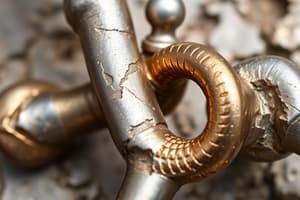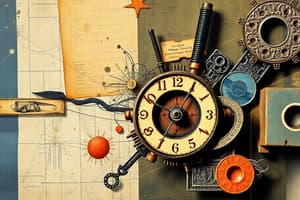Podcast
Questions and Answers
Metals are poor conductors of heat and electricity because they have free electrons.
Metals are poor conductors of heat and electricity because they have free electrons.
False (B)
Lead is one of the best conductors of heat among metals.
Lead is one of the best conductors of heat among metals.
False (B)
Iridium and osmium have low densities compared to other metals.
Iridium and osmium have low densities compared to other metals.
False (B)
Tungsten has the lowest melting and boiling points among metals.
Tungsten has the lowest melting and boiling points among metals.
Metals tend to gain electrons (i.e., be reduced) when they undergo chemical reactions.
Metals tend to gain electrons (i.e., be reduced) when they undergo chemical reactions.
Alkali metals always have a 2+ charge in chemical reactions.
Alkali metals always have a 2+ charge in chemical reactions.
All elements that form positive ions by gaining electrons during chemical reactions are called METALS.
All elements that form positive ions by gaining electrons during chemical reactions are called METALS.
Mercury is the only metal that is liquid at room temperature.
Mercury is the only metal that is liquid at room temperature.
Metals have the ability to reflect light from their surface and can be polished.
Metals have the ability to reflect light from their surface and can be polished.
All metals are malleable and can be pounded into thin sheets known as foils.
All metals are malleable and can be pounded into thin sheets known as foils.
Metals can be drawn into wires, an example being 100 grams of silver drawn into a 200-meter long wire.
Metals can be drawn into wires, an example being 100 grams of silver drawn into a 200-meter long wire.
All metals are hard except for sodium and potassium which are soft and can be easily cut with a knife.
All metals are hard except for sodium and potassium which are soft and can be easily cut with a knife.
Flashcards are hidden until you start studying




